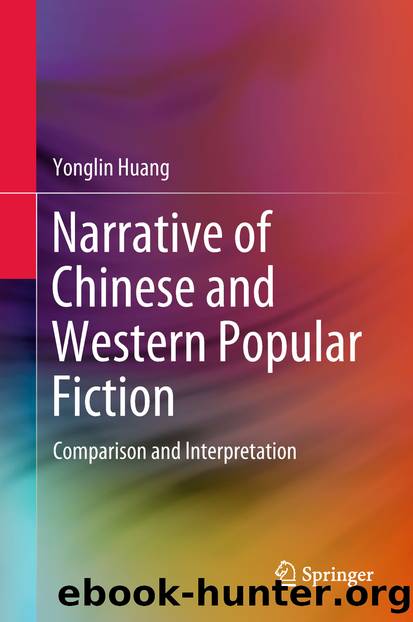Narrative of Chinese and Western Popular Fiction by Yonglin Huang

Author:Yonglin Huang
Language: eng
Format: epub
ISBN: 9783662575758
Publisher: Springer Berlin Heidelberg
Targeting at Fan Erlang, this warning is on the one hand a reflection of the narratorâs somehow conventional and prejudiced view of women as the root of menâs problems, and on the other hand a narrative device to command attention and create suspense through exaggerated information. Indeed, the plot development proves this warning to be an overstatement, for what happened to Erlang in the next section was simply a false alarm, while Shengxian braved all kinds of perils, even rising from the dead. This naturally justifies the narratorâs focusing primarily on the experience of Shengxian for the most part in that section, until Erlang was thrown into prison for accidentally killing Shengxian. The primary plotline about Shengxianâs experience, behavior, thoughts and feelings were interrupted by two incidents, namely, the matchmakerâs diagnosis of Shengxianâs ailment, and the grave robberâs sneaking into the tomb. With vivid details and intriguing plot, these two incidents can be quite entertaining to the audience of the storytelling performance. Inserted into the narrative, however, they may affect the coherence of the story and distract the reader from the main plotline. All through the story, Shengxian and Erlangâs external behavior and inward thoughts are depicted rather distantly instead of intimately. Here is one example of such distant depiction of characterâs inner world: âHaving heard the commotion, the girl said to herself, âWhat better time than this to get away?â Another example is the description of Fan Erlangâs thoughts in the lockup: âHow very strange! If she was a human, she had already died once before. The undertaker who was present at the burial can testify to that, and the grave is also there. But if she was a ghost, she did bleed when hit, and the corpse is still there.â Managing both the content and the structure of the narrative, the narratorâs intrusion in the plot or the mind of the character serves merely the function of moving the story forward or justifying the characterâs behavior without relating to the subtle emotions and sentiments of the character. The narrator enables the reader to see clearly what happens to the characters and how they act or feel, but their very heart and soul remain undisclosed.
An obvious strength of zero focalization lies in the fact that the unlimited birdâs-eye view enables an omniscient narrator to see all and know all. The narrator can access both the external actions and the internal workings of all the characters in the story. This kind of omniscient point of view has a long-standing aesthetic tradition in China. Historically, Chinese novels originated from hearsay and evolved through storytelling. The Narrator >â Character formula put forward by Todorov can best summarize the âbeen there, done thatâ mentality of the usually well-informed storyteller/novelist, who naturally favors the third-person omniscient perspective. To quote from Rimmon-Kenan, âThe extradiegetic narrators ⦠are both extradiegetic and heterodiegetic. It is precisely their being absent from the story and their higher narratorial authority in relation to it that confers on such narrators the quality which has often been called âomniscience.
Download
This site does not store any files on its server. We only index and link to content provided by other sites. Please contact the content providers to delete copyright contents if any and email us, we'll remove relevant links or contents immediately.
Klara and the Sun by Kazuo Ishiguro(2125)
The Fine Print (Dreamland Billionaires Book 1) by Lauren Asher(1921)
The Rose Code by Kate Quinn(1657)
The Last House on Needless Street by Catriona Ward(1618)
Luster by Raven Leilani(1598)
Transcendent Kingdom by Yaa Gyasi(1595)
Moonflower Murders by Anthony Horowitz(1459)
Malibu Rising by Taylor Jenkins Reid(1397)
This Changes Everything by Unknown(1222)
The Lying Life of Adults by Elena Ferrante(1185)
The Midwife Murders by James Patterson & Richard Dilallo(1169)
The Lost Book of the White (The Eldest Curses) by Cassandra Clare & Wesley Chu(1167)
The New Wilderness by Diane Cook(1138)
Written in the Stars by Alexandria Bellefleur(1112)
Ambition and Desire: The Dangerous Life of Josephine Bonaparte by Kate Williams(1100)
The Kindest Lie by Nancy Johnson(1097)
The Lying Life of Adults by Elena Ferrante;(1070)
Every Vow You Break by Swanson Peter(1058)
Wandering in Strange Lands by Morgan Jerkins(1027)
